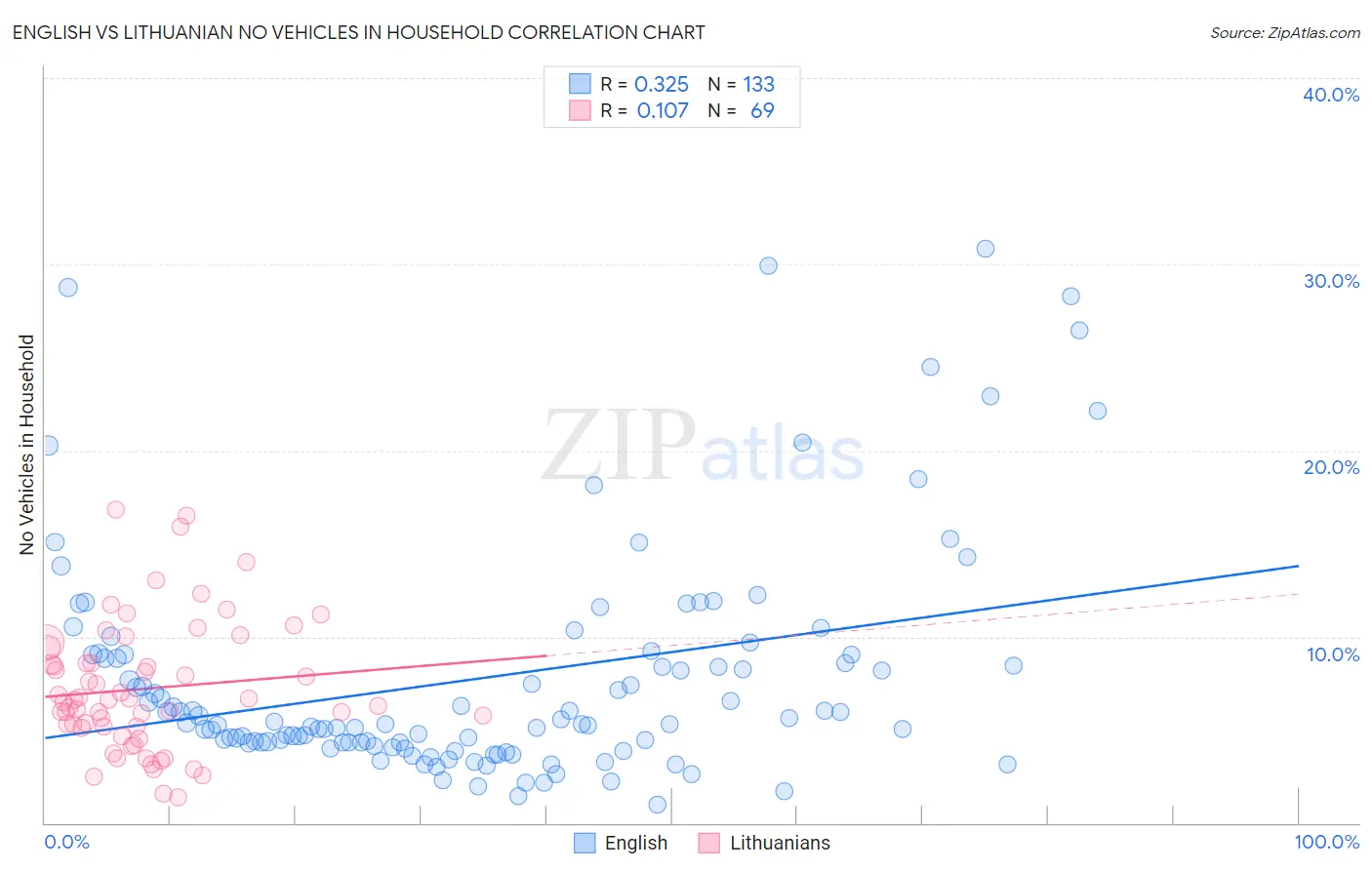English vs Lithuanian No Vehicles in Household
COMPARE
English
Lithuanian
No Vehicles in Household
No Vehicles in Household Comparison
English
Lithuanians
6.5%
NO VEHICLES IN HOUSEHOLD
100.0/ 100
METRIC RATING
3rd/ 347
METRIC RANK
8.4%
NO VEHICLES IN HOUSEHOLD
99.6/ 100
METRIC RATING
72nd/ 347
METRIC RANK
English vs Lithuanian No Vehicles in Household Correlation Chart
The statistical analysis conducted on geographies consisting of 572,648,684 people shows a mild positive correlation between the proportion of English and percentage of households with no vehicle available in the United States with a correlation coefficient (R) of 0.325 and weighted average of 6.5%. Similarly, the statistical analysis conducted on geographies consisting of 420,405,245 people shows a poor positive correlation between the proportion of Lithuanians and percentage of households with no vehicle available in the United States with a correlation coefficient (R) of 0.107 and weighted average of 8.4%, a difference of 29.6%.

No Vehicles in Household Correlation Summary
| Measurement | English | Lithuanian |
| Minimum | 1.0% | 1.4% |
| Maximum | 30.8% | 16.8% |
| Range | 29.8% | 15.5% |
| Mean | 7.8% | 7.2% |
| Median | 5.3% | 6.6% |
| Interquartile 25% (IQ1) | 4.3% | 5.1% |
| Interquartile 75% (IQ3) | 9.0% | 9.0% |
| Interquartile Range (IQR) | 4.7% | 3.9% |
| Standard Deviation (Sample) | 6.1% | 3.5% |
| Standard Deviation (Population) | 6.1% | 3.4% |
Similar Demographics by No Vehicles in Household
Demographics Similar to English by No Vehicles in Household
In terms of no vehicles in household, the demographic groups most similar to English are Norwegian (6.4%, a difference of 1.1%), Danish (6.6%, a difference of 1.2%), Yakama (6.6%, a difference of 1.6%), German (6.7%, a difference of 2.6%), and Scottish (6.8%, a difference of 3.9%).
| Demographics | Rating | Rank | No Vehicles in Household |
| Luxembourgers | 100.0 /100 | #1 | Exceptional 5.4% |
| Norwegians | 100.0 /100 | #2 | Exceptional 6.4% |
| English | 100.0 /100 | #3 | Exceptional 6.5% |
| Danes | 100.0 /100 | #4 | Exceptional 6.6% |
| Yakama | 100.0 /100 | #5 | Exceptional 6.6% |
| Germans | 100.0 /100 | #6 | Exceptional 6.7% |
| Scottish | 100.0 /100 | #7 | Exceptional 6.8% |
| Swedes | 100.0 /100 | #8 | Exceptional 6.8% |
| Scotch-Irish | 100.0 /100 | #9 | Exceptional 6.8% |
| Dutch | 100.0 /100 | #10 | Exceptional 6.8% |
| Czechs | 100.0 /100 | #11 | Exceptional 6.9% |
| Assyrians/Chaldeans/Syriacs | 100.0 /100 | #12 | Exceptional 7.0% |
| Scandinavians | 100.0 /100 | #13 | Exceptional 7.0% |
| Mexicans | 100.0 /100 | #14 | Exceptional 7.0% |
| Whites/Caucasians | 100.0 /100 | #15 | Exceptional 7.0% |
Demographics Similar to Lithuanians by No Vehicles in Household
In terms of no vehicles in household, the demographic groups most similar to Lithuanians are Immigrants from Lebanon (8.4%, a difference of 0.030%), Polish (8.4%, a difference of 0.030%), Cajun (8.4%, a difference of 0.060%), Spaniard (8.4%, a difference of 0.78%), and Immigrants from Iran (8.4%, a difference of 0.84%).
| Demographics | Rating | Rank | No Vehicles in Household |
| Canadians | 99.7 /100 | #65 | Exceptional 8.3% |
| Palestinians | 99.7 /100 | #66 | Exceptional 8.3% |
| Immigrants | Scotland | 99.7 /100 | #67 | Exceptional 8.3% |
| Immigrants | Iran | 99.7 /100 | #68 | Exceptional 8.4% |
| Spaniards | 99.7 /100 | #69 | Exceptional 8.4% |
| Cajuns | 99.6 /100 | #70 | Exceptional 8.4% |
| Immigrants | Lebanon | 99.6 /100 | #71 | Exceptional 8.4% |
| Lithuanians | 99.6 /100 | #72 | Exceptional 8.4% |
| Poles | 99.6 /100 | #73 | Exceptional 8.4% |
| Cubans | 99.5 /100 | #74 | Exceptional 8.5% |
| Jordanians | 99.5 /100 | #75 | Exceptional 8.5% |
| Immigrants | Philippines | 99.5 /100 | #76 | Exceptional 8.5% |
| Iranians | 99.5 /100 | #77 | Exceptional 8.6% |
| Immigrants | South Central Asia | 99.5 /100 | #78 | Exceptional 8.6% |
| Portuguese | 99.5 /100 | #79 | Exceptional 8.6% |